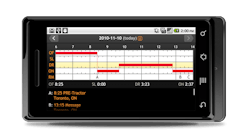When the Federal Motor Carrier Safety Administration was forced by court decision to rescind its electronic onboard recorder (EOBR) rule in 2011, it was considered a win for drivers everywhere. The Owner-Operator Independent Drivers Association (OOIDA) had fought the rule on the grounds that the devices, which monitor hours-of-service compliance, could be used by fleets as a tool to harass drivers, violating privacy rights under the Fourth Amendment.
Fast-forward nearly two years, and once again the subject of EOBRs is coming to the forefront of industry discussion. Driven by the need for drivers to meet new hours-of-service regulations set to go into effect this summer, more and more carriers are implementing EOBRs.
And with FMCSA required by the Moving Ahead for Progress in the 21st Century Act, or MAP-21, to issue a new EOBR regulation, fleets are trying to get out in front of any mandate.
“For starters, the new hours-of-service (HOS) rules that are going into effect [in July] will be difficult to comply with manually using paper logbooks,” explained John Gaither, senior sales executive and engineer for technology provider GPS Insight. “Use of EOBRs will not only reduce the amount of time required to keep logbooks in compliance, they can also help fleets improve their Compliance, Safety, Accountability (CSA) scores as well.”
What exactly is an EOBR and what data does it capture? For starters, XRS Corp. said an EOBR must record the name of driver and any co-driver(s), along with corresponding driver identification information. Other important information EOBRs must track in order to be compliant include: Driver duty status; date and time; vehicle location; distance traveled; name and DOT number; 24-hour period starting time; the multiday basis used by the carrier to compute cumulative duty hours and driving time; and truck or tractor and trailer number.
While any new EOBR regulation is bound to be challenged in court again, the fact remains that fleets are implementing the systems and drivers must adjust. So what exactly can an EOBR do? According to a number of experts, there are plenty of advantages to using an EOBR.
Dave Kraft, director of industry affairs for Qualcomm Enterprise Services, said drivers do not actually find the devices intrusive. “We’ve found that once EOBRs are in place, it not only improves time management for drivers and logging accuracy, it reduces job stress to a degree since the devices now automatically track metrics they used to have to calculate by hand,” he said during a webinar last fall.
Another benefit of EOBRs, Kraft said, is a significant reduction in paperwork and other administrative costs connected to managing paper logbooks. Qualcomm’s research indicates that a move to EOBRs could eliminate 688 hours of administrative work per driver per year and, because drivers are more accurately recording hours and spending less time on paperwork, they have more available drive time as well. And that can add up to increased salary for those drivers who are paid by the mile.
Kraft said that there’s been a 12% reduction in total logbook violations and a corresponding 12% decline in out-of-service tallies linked to hours-of-service violations over the past several years as EOBR usage has increased.
Tom Cuthbertson, vice president-regulatory compliance for XRS, said EOBR data can also help fleets and owner-operators charge for detention time. “With the data [from EOBRs] to support those extra charges, carriers have the ability to bill for the time and compensate their drivers accordingly,” he said.
Gaither also draws a connection between EOBRs and improved CSA scores, claiming that eight types of HOS violations under CSA can be virtually eliminated by using EOBRs, especially in terms of providing roadside inspectors with a simple way to check logbook data.
Many EOBRs also integrate map and route solutions which can help drivers navigate around construction and avoid high-traffic areas, XRS said, providing drivers with a multi-solution answer in a single device.
Drivers may never embrace the devices, but it appears their introduction into commercial vehicles of all types may be near. And in the end, if the software providers are correct, drivers may find that they provide more help than harm to the 21st century trucker.



